Understanding the Significance of Control Valves in Process Automation
Understanding the Significance of Control Valves in Process Automation
Blog Article

Maximize Power Savings and Convenience With Advanced Building Automation Controls
In the world of contemporary design and facility administration, the assimilation of advanced building automation manages stands as an essential advancement. By harnessing the power of automation, buildings can adapt, respond, and evolve in ways that were when unthinkable.
Power Efficiency Benefits
Power effectiveness advantages can significantly reduce power intake and operational costs in buildings. By executing energy-efficient methods and modern technologies, structure owners and operators can attain significant savings while likewise adding to ecological sustainability. Among the key advantages of improving energy performance in buildings is the reduction of utility expenses. Energy-efficient systems, such as advanced structure automation controls, can enhance making use of sources like heating, cooling, and lighting, causing lower energy expenditures in time.
Additionally, enhanced energy efficiency can lengthen the lifespan of structure devices and systems. By running a lot more efficiently, HVAC systems, lighting fixtures, and various other building elements experience much less deterioration, resulting in reduced upkeep and substitute costs. Additionally, energy-efficient structures frequently regulate higher residential property worths and rental prices, supplying long-lasting monetary advantages to owners.
In addition, power effectiveness can enhance passenger comfort and performance. Correctly regulated indoor settings with ideal illumination and thermal problems create an even more positive and helpful work area, bring about improved employee complete satisfaction and performance. Overall, the power efficiency advantages linked with advanced structure automation controls are diverse, incorporating cost savings, ecological stewardship, and resident wellness.
Improved Convenience Control
Enhancing convenience control in building atmospheres needs a sophisticated assimilation of sophisticated automation systems for optimum owner well-being. By using sophisticated structure automation controls, centers can tailor the interior atmosphere to meet the specific requirements and choices of owners. control valves.
By integrating these sophisticated controls, buildings can not just boost convenience yet additionally improve energy effectiveness by maximizing system operations based on actual occupancy and usage patterns. Eventually, focusing on owner convenience via innovative automation systems leads to a much more enjoyable and healthier interior atmosphere.
Functional Effectiveness Improvements

In addition, the implementation of real-time tracking and analytics devices enables building operators to determine energy inadequacies and operational anomalies promptly. By constantly keeping an eye on energy use patterns and system performance metrics, adjustments that site can be made in real-time to maximize power intake and ensure peak operational performance. control valves. In addition, integrating demand action strategies right into building automation controls can additionally enhance operational efficiency by dynamically changing power usage based upon grid problems and prices signals
Indoor Environment Optimization
Efficient interior climate optimization is a fundamental facet of building automation controls, making certain occupants' convenience and health while maximizing power cost savings. By using sophisticated sensing units and controls, building automation systems can continuously adjust and check temperature level, humidity degrees, air quality, and ventilation to create an ideal interior environment. Maintaining regular and comfy problems not just boosts passenger contentment yet likewise boosts efficiency and total wellness.
Indoor environment optimization likewise plays a critical duty in power effectiveness. By fine-tuning home heating, air flow, and cooling systems based upon real-time data and tenancy patterns, building automation controls can considerably decrease power intake - control valves. Executing techniques such as demand-controlled air flow and thermal zoning can assist minimize power waste while making certain that each area of the structure gets the necessary conditioning.

Sustainable Environment Production
Building automation regulates not just maximize interior climate conditions for power performance and owner convenience but additionally lay the structure for creating a sustainable setting via critical management of systems and sources. By integrating advanced building automation innovations, such as sensing units, actuators, and intelligent software, centers can adjust and keep an eye on energy usage in real-time to decrease waste and minimize their carbon footprint. These systems enable anticipating maintenance, recognizing prospective issues prior to they intensify and optimizing tools efficiency to enhance long life and effectiveness.
Furthermore, lasting environment production prolongs beyond power management to incorporate water preservation, waste reduction, and interior air quality renovation. Building automation controls can manage water usage, spot leakages, and guarantee correct waste disposal techniques, contributing to general sustainability initiatives. Furthermore, by keeping track of and regulating air flow and filtering systems, these modern technologies improve owner health and wellness and performance while decreasing power consumption related to HVAC procedures.
Conclusion
Finally, progressed building automation manages deal significant benefits in regards to power savings, convenience control, functional performance, indoor climate optimization, and developing a sustainable atmosphere. By carrying out these controls, buildings can achieve optimum performance while decreasing energy consumption and boosting resident convenience. It is evident that the use of advanced automation technology is critical in enhancing building performance and creating a much more sustainable future.
Energy performance advantages can considerably minimize power intake and functional costs in buildings. In general, the energy performance advantages associated with this content advanced building automation controls are multifaceted, encompassing price financial savings, ecological stewardship, and resident well-being.
Additionally, incorporating demand response methods right into structure automation controls can even more enhance functional performance by dynamically changing energy use based on grid problems and prices signals.
Building automation regulates not only optimize interior climate problems for power effectiveness and occupant convenience yet also lay the structure for developing a sustainable atmosphere via tactical management of sources and systems.In verdict, progressed building automation controls deal considerable benefits in terms of power savings, convenience control, operational effectiveness, indoor environment optimization, and creating a lasting environment.
Report this page